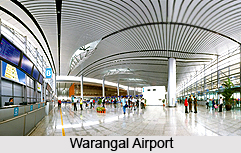 Warangal Airport is situated at Mamnoor in Warangal district in the South Indian state Telangana. It is an old airport and is credited as the largest pre-independence era airport of the country. In the past times, the airport was often used by several VIPs including various Prime Ministers and Presidents who used to land here till the year 1981. Presently Warangal Airport serves as a domestic airport used by the general public for travelling purpose.
Warangal Airport is situated at Mamnoor in Warangal district in the South Indian state Telangana. It is an old airport and is credited as the largest pre-independence era airport of the country. In the past times, the airport was often used by several VIPs including various Prime Ministers and Presidents who used to land here till the year 1981. Presently Warangal Airport serves as a domestic airport used by the general public for travelling purpose.
History of Warangal Airport
Warangal Airport was commissioned by last Nizam named Mir Osman Ali Khan. He also built the one at Sholapur. It was built in the year 1930 mainly constructed to help the industries in their business and trading. Paper industries were much benefited by it. Paper from this region was imported as well as exported to different parts of the country by Azam Zahi mills. During the famous Indo-China war, the airport served as a prominent airbase for the government aircraft as the Delhi airport was a target in the combat. It has been also used by many cargo services and Vayudoot services as their hub.
Infrastructure of Warangal Airport
In the bygone era, Warangal Airport was the largest airport of the country. It spans over an area of 1875 acres with a 6.6 km runway, more than one terminal, a pilot training centre and a pilot and staff quarters. Terminal 1 of Warangal Airport operates various domestic flights. This terminal underwent renovation in the year 2007 and has been equipped with all the latest facilities. From this airport travellers can get a flight to about six major destinations of India. The services of Warangal Airport were controlled by Airport Authority of India. Post independence, Warangal Airport Authority was established which took over the control including air traffic control, maintenance and security. It also looks after the control tower which monitors the air traffic and all the flight schedules.
Facilities at Warangal Airport
The baggage services of Warangal Airport include security scanners for baggage, lost and found baggage counters, wheel chair and escort for physically disabled persons and free trolleys. Checking of all baggage is done to assure security of the premises. Various shops are also located in the premises where the travellers can spend time and shop. Restaurants, snack bars and food stalls also serve the visitors with diverse delicacies.















